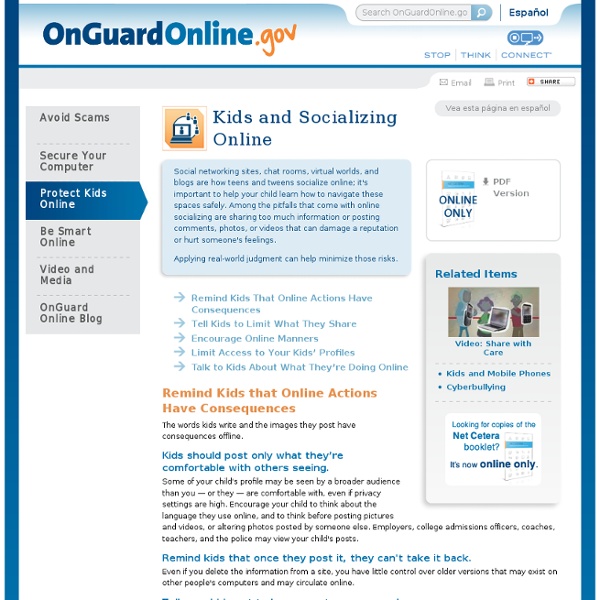Online Privacy: Using the Internet Safely | Privacy Rights Clear
Copyright © 1995 - 2014Privacy Rights Clearinghouse Introduction Introduction As consumers increasingly go online in so many aspects of their daily lives, the challenge is enjoy the conveniences of online activities while limiting the privacy sacrifices. Most internet users would like to be anonymous online, but many think it is not possible to be completely anonymous online. This fact sheet explains how your online activities may compromise your privacy and the steps you can take to protect youself. 1: Which Online Activities Reveal My Personal Information? When you are online, you provide information to others at almost every step of the way. Signing up for Internet service If you use a computer to access the Internet and pay for the service yourself, you signed up with an Internet Service Provider (ISP). Each computer connected to the Internet, including yours, has a unique address, known as an IP address (Internet Protocol address). Browsing the Internet Search engines. Cookies.
Family Genealogy and History Internet Education Directory
Broadband - OnGuard Online
You can get high-speed internet access through a variety of services, including: digital subscriber line (DSL) cable fiber optic satellite wireless When you’re shopping for internet service, it helps to understand the differences and know what questions to ask. Types of High-Speed Internet Service The type of internet service available to you depends on what technology your local providers offer: Digital Subscriber Lines (DSL) transmit data through phone lines without interfering with telephone service. Cable modems provide access to the internet through cable lines without interfering with your cable TV service; cable companies provide this service. Fiber optic service provides internet, phone, and TV services delivered simultaneously through one fiber optic line. Satellite internet service is available in most areas from providers of satellite television services. There also are wireless internet options available in some areas: How Fast Is Fast? Questions to Ask When Shopping Ask providers:
Netvibes Adds Slick Magazine Layout Options; Supports OpenSocial
The widget is ready for its closeup. Today at the LeWeb conference in Paris, Netvibes announced a major step forward in how widgets are presented on a start page. Instead of the standard jumble of boxes filled mostly with text-only feeds, Netvibes members can now arrange the different widgets they subscribe to in different layouts that help to break up the page. And within a given widget, they can choose different viewing options for how they see each feed, including carousel view, magazine, streaming ticker, and normal text-headline views. Maybe I’m just excited about this because I’m a former magazine guy, but I always thought Netvibes and most other start pages were way too ugly. Netvibes is not alone in thinking about how to present collections of widgets in a more graphic way. To change the layout of an entire page within Netvibes, you click on the option pull-down menu arrow on each tab and pick your layout.
Privacy Guide
A Pocket Guide to Social Media and Kids
Pete Blackshaw, Executive Vice President, Digital Strategic Services, The Nielsen Company SUMMARY: When is a phone not a phone? In the hands of children and tweens, today’s cell phones are primarily used as text messaging devices, cameras, gaming consoles, video viewers, MP3 players, and incidentally, as mobile phones via the speaker capability so their friends can chime in on the call. Parents are getting dialed in to the social media phenomenon and beginning to understand—and limit—how children use new media.This article draws from a keynote speech delivered last month at the Children’s Advertising Review Unit (CARU) annual conference. Digital media is an enabling framework for brands, parents and educators—it’s on demand, interactive, sensing and connected. And social media adds expression and sharing capabilities. Their influence is immediate, highly viral and authentic... In the marketing world, the buzz is all about consumer-generated media. Giving voice Childhood connections TV times
Internet privacy
Internet privacy involves the right or mandate of personal privacy concerning the storing, repurposing, provision to third-parties, and displaying of information pertaining to oneself via the Internet. Internet privacy is a subset of computer privacy. Privacy concerns have been articulated from the beginnings of large scale computer sharing.[1] Privacy can entail either Personally Identifying Information (PII) or non-PII information such as a site visitor's behavior on a website. Some experts such as Steve Rambam, a private investigator specializing in Internet privacy cases, believe that privacy no longer exists; saying, "Privacy is dead – get over it".[2] In fact, it has been suggested that the "appeal of online services is to broadcast personal information on purpose Levels of privacy[edit] People with only a casual concern for Internet privacy need not achieve total anonymity. Posting things on the Internet can be harmful or in danger of malicious attack. HTTP cookies[edit]



